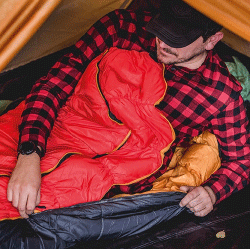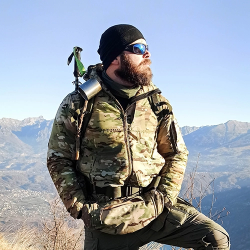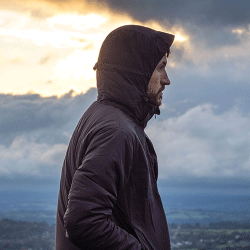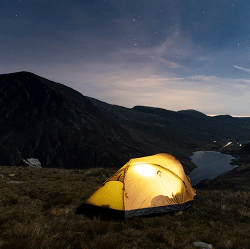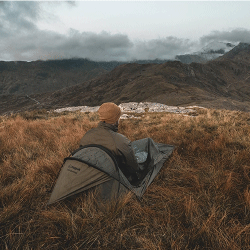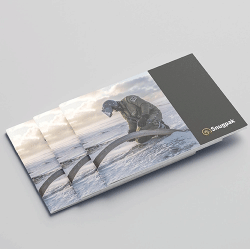
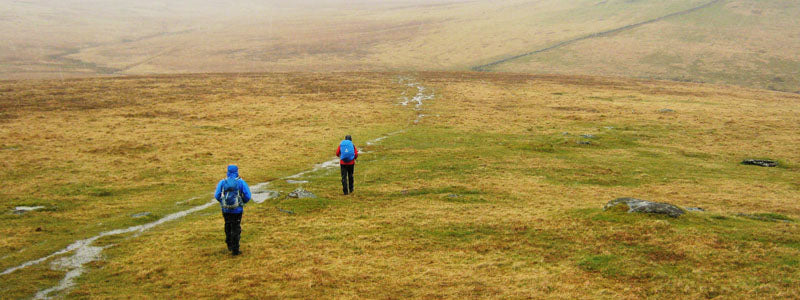
Wind Chill, Evaporative Heat Loss & First Aid On The Hills.
Wind Chill or the 'Feels Like' Temperature can have a dramatic effect on any venture. This article explains in depth how to interpret the figures and includes a handy printout and a keep guide for calculating the 'feels like' temperature from ambient conditions.
Even on low-level walks, clothing choices, minor injuries, and poor weather can quickly escalate into life-threatening emergencies. Learn what you can do to prepare yourself to reduce the risks of injury, illness and prevent hypothermia.
The article includes practical advice on risk assessing your trip, guidance on what type of items to carry in your personal first aid kit and an overview of what to do when confronted with an emergency situation in the field.

Wind Chill & Its Impact
The Wind-Chill Factor, or 'Feels Like' temperature, is a perceived drop in ambient temperature due to evaporative cooling and convection heat loss. Wind or air movement rapidly strips away the thin layer of warm air next to the skin, making it feel significantly colder than the actual temperature.
Wind chill measurements will always be lower than the actual air temperature, but they cannot cause a temperature drop below the ambient temperature. To calculate wind chill, you need to know two critical factors: The actual wind speed and the ambient temperature.
It is important to understand that Wind Chill accelerates heat loss, but it will not cause cooling below the actual ambient temperature. Even though it feels much colder, it actually isn't.
In 2001, the United Kingdom developed a new Wind Chill Index developed by medical experts on the Joint Action Group for Temperature Indices. This newer model determines the 'feels-like' skin temperature under different wind speeds above 3.0 mph and with an ambient air temperature below 10℃. Heat transfer is calculated on a bare face and assumes that you are in an open area exposed to the wind.
As the ambient temperature drops and wind speed increases, evaporative and convective heat loss also increase. Remember that the more energy you have (heat), the quicker you will lose it. Now, if the temperature is low and the wind speed is high, you will rapidly undergo convective cooling, creating a chilling effect!
Understanding Wind Chill
To understand Wind Chill quickly and easily, you will need the following: A finger (either hand will do), a glass of cold water, and the ability to walk from indoors to outside. While you are indoors, place your finger in the water for a few seconds and then hold it up at face height. Gently blow on the end of your finger, and it will feel colder than it is indoors. This is the effect of evaporative or convective heat loss.
Now, to really feel the effects, go outdoors and repeat. The ambient temperature will be cooler than inside your home, and you will also experience some air movement outdoors. Place your finger into the water, hold it up, and gently blow again. This time, your finger will feel a lot colder than it does indoors.
As the ambient air temperature falls, when you move from indoors to outdoors, and net air movement increases, the chilling effect increases. Look at the Windchill Chart and compare the feels-like temperature for an ambient temperature of -3.9°c (a cold winter’s day in the UK) with wind speeds of 10 mph and 25mph.
Protection Against Wind Chill
The easiest way to protect yourself against winter's wind chill is to insulate yourself against the surrounding environment. We need to achieve a layering effect so that we are neither too hot nor too cold, and most importantly, protected from the wind. Many use a protective outer layer that is windproof, thus inhibiting the effect of convection heat loss.
Of course, to be protected against the elements, you need to start with a suitable base layer, such as the Snugpak 2nd Skinz Coolmax Long Sleeve Top and quality socks. Suitable gloves and a warm hat are essential in cold weather and windy conditions. Base layers help wick moisture away from the skin and help trap warm air as we exercise, keeping us drier for longer.
We then need to select our main insulating layer from the Snugpak range. There are three distinct thicknesses of Softie® Premier Insulation, with weights of 3, 6, and 9 Fills.
When purchasing Snugpak clothing, consider adding appropriate mid-layers based on the environment you'll be in. Avoid wearing clothing that makes you too warm, as this can reduce the effectiveness of insulation and hinder your body's ability to release excess heat when needed. Only you know how warm you tend to get while walking and enjoying your adventure.
An Introduction to First Aid (On the Hills):
First aid is about reducing the effects of injury or illness. You need to have the right first-aid supplies for the situation. Do you have enough equipment for the risks and physical challenges of activities like mountaineering, hill walking, climbing, and bushcraft?
Can you?
- Give immediate assistance to casualties with both common injuries or illnesses and those likely to arise from outdoor ventures?
- Summon an ambulance or other medical professional for help?
One-day Emergency First Aid (EFA) training enables an individual to provide first aid to someone who is injured or becomes ill. Three-day First Aid at Work (FAW) training includes EFAW and equips the first aider to apply first aid to a range of specific injuries and illnesses, depending on the environment, terrain, and various risks.
If you are regularly participating in outdoor activities, attending a one-day EFA course will provide you with essential skills for dealing with common emergencies, and there are many companies out there that provide specific training for outdoor ventures.
First Aid is defined as:
“(a) In cases where a person will need help from a medical practitioner or nurse, treatment for the purpose of preserving life and minimising the consequences of injury and illness until such help is obtained, and
(b) Treatment of minor injuries which would otherwise receive no treatment or which do not need treatment by a medical practitioner or nurse;”
- Health and Safety (First-Aid) Regulations 1981
First Aid in Remote Environments
A distinction must be made: while First Aid encompasses many skills, including Cardiopulmonary Resuscitation (CPR), its core purpose is to preserve life and prevent cardiac arrest. In cases of severe trauma or injury, particularly in remote areas, the likelihood of CPR being successful is often minimal.
In an emergency: Dial 999 or 112. If in mountainous or remote areas, ask for the Police, who will then coordinate Mountain Rescue or Ambulance services.
When participating in outdoor ventures, it's better to think of first aid as emergency care, doing what you can for yourself or your casualty and preventing the deterioration of signs and symptoms before seeking professional help.
In the Hills, this is likely to be from Mountain Rescue. For remote and urban locations, the Police and specialised assistance, such as the Hazardous Area Response Team (HART) from the Ambulance Service, as well as additional support from the Fire Rescue Service and other search and rescue teams, may also be called.
Hypothermia
Hypothermia is one of the most significant factors affecting injured casualties in outdoor ventures, regardless of the time of year or location. Because of wind chill and convective heat loss, hypothermia can affect people on warm days when out on the hills. Understanding weather systems and hypothermia is essential so that you can plan ahead and carry suitable equipment.
For anyone venturing out onto the hills, a suitable first aid kit needs to be carried, along with an understanding of how to use its contents.
Hypothermia is the “accidental reduction of [core] body temperature below the normal range in the absence of protective reflex actions." The normal body temperature range is between 36.0°c and 37.0°c, and Hypothermia is defined as a core body temperature of below 35.0°c.
Sub-acute (or exhaustion) hypothermia is the most common type seen in outdoor activities like hill walking. It happens when the body runs out of energy and can no longer produce heat. Chronic hypothermia develops over longer trips due to prolonged heat loss, often made worse by a poor diet or damp conditions.
When Planning Your Venture, Consider:
- The type of venture and associated hazards and risks;
- History of accidents at the location (i.e., Dartmoor, Snowdonia, etc and what has happened)
- The size of your group, or the risks of being alone;
- The remoteness of the site from emergency medical services.
The Risk Assessment determines the quantity and contents of your First Aid Kit...
This plan forms a risk assessment for your planned venture. Consider taking your dog for a walk around the local area near home. Would you do this without a first aid kit? Most probably yes. Although there are many perceived risks, most are unlikely. Do you have a history of tripping, falling or getting injured whilst walking your K9 companion? How far are you from home in the event of an emergency?
Now consider the same question, but for a planned walk across Dartmoor, or a weekend rock climbing in Snowdonia - the risk assessment changes dramatically.
What Should I Carry in My First Aid Kit?
Under the Guidelines Issued by the Health and Safety Executive, there is no mandatory list of items to include in a first-aid kit. Based on your risk assessment, above, an example of equipment could include the following items:
- An aide memoire, giving guidance on first aid;
- Some Disposable Nitrile (Latex-free) Gloves;
- Wound Cleansing Wipes;
- Assorted Individually Wrapped Sterile plasters;
- Two Medium-sized Sterile wound Dressings;
- A Large Sterile Wound Dressing;
- Two Large Safety Pins;
- Two Individually Wrapped Triangular Bandages;
A small ‘personal’ First Aid Kit can be easily carried in a pocket, or on top of a small rucksack, and will provide you with basic supplies to deal with minor injuries such as cuts, grazes and blisters.
If you buy an off-the-shelf first aid kit, make sure to check the contents and personalise it for your own requirements, depending on your planned venture.

If you buy an off-the-shelf first aid kit, make sure to check the contents and personalise it for your own requirements, depending on your planned venture.
When Providing First Aid, Follow the cABCDE Approach
When dealing with significant injuries, the most important aspect of first aid is a systematic approach to dealing with your casualty, as well as communicating information to the emergency services.

Before approaching any casualty, in any environment, ALWAYS consider YOUR SAFETY! Do not put yourself in harm's way and ensure you can respond and get help. This may seem backwards, but obtaining professional help before assisting a casualty can often be life-saving. If you don't call for help, then the simple fact is: no help will come!
Catastrophic Bleeding:
Try to stop all significant and catastrophic bleeding using direct pressure and wound dressings. Elevate the wound above the level of the heart to assist in the reduction of blood flow to the wound, only if it is safe to do so; i.e. do not elevate broken legs, etc.
Airway Management:
Make sure the mouth is clear and the airway is open, using a head tilt and chin lift, or ask the casualty to lean forward to allow fluids and debris to drain from their mouth. Place the casualty in the Recovery Position if they are unconscious, with the airway open.
Breathing Problems:
Are they breathing normally? Too Fast? Too Slow? The normal breathing rate for an adult is 12 to 20 breaths per minute. Look, listen and feel for normal breathing for up to 10 seconds in an unconscious casualty. If they are not breathing normally, you may have to start CPR (Resuscitation).
Circulation:
Is the heart beating? Finding a Pulse in the outdoor environment is all but impossible; instead, press down on the forehead or centre of the chest with your thumb for 5 seconds, blanching the skin. If the skin does not return to a normal pink colour in less than 2 seconds, there may be a circulation problem.
Disability (Neurological):
Is the casualty conscious? (If not, place in the Recovery Position.) The level of consciousness is measured in one of four categories called AVPU: Alert (Conscious), Responding to Voice, Responding to Pain and Unresponsive (Unconscious).
Environment & Exposure:
Where possible, and only if safe to do so, move the casualty out of the elements, including wind and rain, and protect them as best as possible from the effects of convection and conduction heat loss.
ETHANE
ETHANE is a mnemonic indicating a protocol used by emergency services to communicate time-critical information and to ensure appropriate resources are considered, especially if the incident response may challenge the available resources and necessitate initiating additional contingency plan measures, such as coordination of other rescue services for prompt evacuation of a casualty.
The acronym dictates the form in which the emergency services should get information from the first person or responding at the scene:
- Exact Location: Ordnance Survey 10-Figure Grid Reference with geographic descriptions of where you are.
- Type of Incident: What has happened?
- Hazards/HLS: Are there any dangers on approach to the scene? Is there a suitable area for landing a helicopter?
- Access: How can emergency services reach your casualty?
- Number of Casualties/Type of injuries: How many people are injured and to what severity?
- Emergency Services Required: What help do you need? Ambulance, Fire Rescue, etc.
When you speak with the emergency services operator, listen carefully to all the questions asked. The conversation will be very one-sided, i.e. the operator will ask all the relevant questions. ETHANE is all the information you need to provide, and ideally, you should have all this information before you dial 999.
First Aid Training:
Training organisations should use training materials and teach the first-aid management of injuries and illness, as covered in HSE First Aid at Work and Emergency First Aid Standards and in accordance with:
- Current guidelines published by the Resuscitation Council (UK)
- The current edition of the first-aid manual of the Voluntary Aid Societies (St John Ambulance, British Red Cross, St Andrew's First Aid)
- Other published guidelines, provided they are in line with the two above or supported by a responsible body of medical opinion.
The latest 11th Edition of the standard First Aid Manual is an ideal companion for anybody involved in outdoor activities, but it does not substitute for or replace face-to-face training from a qualified instructor.
An HSE Emergency First Aid (EFA) One-day Course will cover the following topics as a minimum, and on completion of the training, successful participants should be able to:
- Understand the role of the first-aider, including reference to
- The importance of preventing cross-infection
- The need for recording incidents and actions
- Use of available equipment
- Assess the situation and circumstances in order to act safely, promptly and effectively in an emergency.
- Administer first aid to a casualty who is unconscious (including a convulsion/seizure)
- Administer cardiopulmonary resuscitation
- Administer first aid to a casualty who is choking, wounded, bleeding, or suffering from shock.
- Provide appropriate first aid for minor injuries (including small cuts, grazes and bruises, minor burns and scalds, small splinters).
First aid is a life skill for everyone, regardless of outdoor activity, and learning it will boost your confidence when exploring the outdoors. Along with navigation and weather forecasting, basic outdoor skills help you enjoy your adventures without worrying about things going wrong, especially when it’s already too late to fix them.
If you are reading the ‘How to...’ information sheet in your pre-packed first aid kit when dealing with an injury on the hills, you will find dealing with even the most minor injuries to be both difficult and stressful. Take the time to plan ahead and ensure you are adequately equipped with outdoor essentials and the correct clothing for the environment, terrain, and weather.
The contents of this article do not constitute First Aid training, nor should it be used as a substitute for professional training from an authorised training provider, and it is provided as information only.

